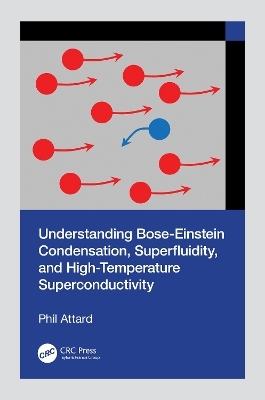
Understanding Bose-Einstein Condensation, Superfluidity, and High-Temperature Superconductivity
CRC Press (Verlag)
978-1-032-82393-5 (ISBN)
- Lieferbar (Termin unbekannt)
- Versandkostenfrei
- Auch auf Rechnung
- Artikel merken
This book presents these phenomena in terms of particles, their positions, and their momenta, giving a concrete visualisation and description that is not possible with traditional wave functions. A single approach that bridges the classical-quantum divide provides new insight into the role of particle interactions in condensation, the nature of collisions in superfluid flow, and the physical form of Cooper pairs in high-temperature superconductors.
High-temperature superconductivity is explored with quantum statistical mechanics, which links it to Bose-Einstein condensation. Identifying a new mechanism for Cooper pairing, this explains the differences between the low- and high-temperature superconducting regimes and the role of the molecular structure of the conductor.
The new perspective offered by this book on Bose-Einstein condensation, superfluidity, and high-temperature superconductivity gives particle-based explanations as well as mathematical and computational methods for these macroscopic quantum phenomena so that readers understand the role of particle interactions and structure in the physics of these phenomena.
This book will appeal to undergraduate and graduate students, lecturers, academics, and scientific researchers in the fields of Bose-Einstein condensation and condensates, superfluidity, and superconductivity. It will also be of interest to those working with thermodynamics, statistical mechanics, statistical physics, quantum mechanics, molecular dynamics, materials science, condensed matter physics, and theoretical chemistry.
Key Features:
· Explores Bose-Einstein condensation with new evidence for multiple condensed states and novel Monte Carlo simulations for interacting bosons
· Establishes the thermodynamic nature of condensed bosons from an analysis of fountain pressure measurements, including that they carry energy and entropy, and the thermodynamic principle of superfluid flow
· Derives equations of motion for condensed bosons, and performs molecular dynamics simulations of the viscosity with molecular trajectories that give rise to superfluidity
· Identifies the mechanism for electron pairing in high-temperature superconductivity
Dr Phil Attard is an independent research scientist working broadly in classical and quantum statistical mechanics, equilibrium and non-equilibrium thermodynamics, and colloid science. He was a Professorial Research Fellow of the Australian Research Council and has authored some 150 papers with over 7000 citations. He has contributed measurement techniques for atomic force microscopy, computer simulation and integral equation algorithms for condensed matter, the second entropy principle for non-equilibrium thermodynamics, the classical phase space formulation of quantum statistical mechanics, and nanobubbles.
Chapter 1: Introduction. Chapter 2: Ideal Boson Model of Condensation. Chapter 3: Interacting Bosons and the Condensation Transition. Chapter 4: Fountain Pressure and Superfluid Flow. Chapter 5: Molecular Dynamics of Superfluidity. Chapter 6: High-Temperature Superfluidity. Chapter 7: Quantum Statistical Mechanics. References. Index.
| Erscheinungsdatum | 02.11.2024 |
|---|---|
| Zusatzinfo | 7 Tables, black and white; 60 Line drawings, black and white; 60 Illustrations, black and white |
| Verlagsort | London |
| Sprache | englisch |
| Maße | 156 x 234 mm |
| Themenwelt | Mathematik / Informatik ► Mathematik ► Angewandte Mathematik |
| Naturwissenschaften ► Biologie | |
| Naturwissenschaften ► Physik / Astronomie ► Atom- / Kern- / Molekularphysik | |
| Naturwissenschaften ► Physik / Astronomie ► Plasmaphysik | |
| Naturwissenschaften ► Physik / Astronomie ► Quantenphysik | |
| Technik ► Elektrotechnik / Energietechnik | |
| ISBN-10 | 1-032-82393-3 / 1032823933 |
| ISBN-13 | 978-1-032-82393-5 / 9781032823935 |
| Zustand | Neuware |
| Informationen gemäß Produktsicherheitsverordnung (GPSR) | |
| Haben Sie eine Frage zum Produkt? |
aus dem Bereich


